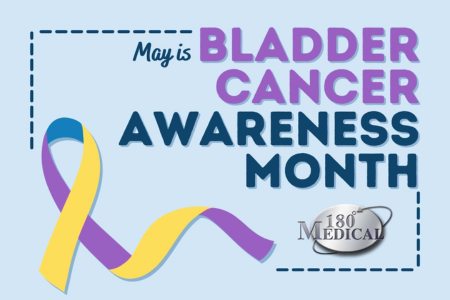
Did you know that May is Bladder Cancer Awareness Month? If we all work to better understand and share the potential risk factors and signs of bladder cancer, perhaps we can better prevent it and get closer to finding a cure someday.
What are the Symptoms of Bladder Cancer?
Bladder cancer happens when the cells in the bladder’s inner layers begin to divide and grow without stopping. When left untreated, it can grow out of control and even spread to the lining of the kidneys, ureters, and urethra.
Common bladder cancer symptoms include:
- Blood in the urine that may appear intermittently
- Irritation or pain when urinating
- More frequent urge to urinate
However, it’s important to remember that these symptoms don’t always add up to cancer. For example, blood in urine, burning or pain during urination, and increased urgency may actually be signs of a urinary tract infection.
Consider scheduling regular or annual check-ups with your primary care physician. They’re the best source for medical advice, and they can better diagnose and treat any issues you may be experiencing. If you’re experiencing any unusual symptoms, you should see your healthcare professional or urologist as soon as possible.
Video Source: Bladder Cancer Advocacy Network
Who is at Risk of Developing Bladder Cancer?
Bladder cancer can happen to anyone, although certain demographics may be at a higher risk. According to the American Cancer Society, recent statistics indicate “about 80,470 new cases of bladder cancer (about 61,700 in men and 17,770 in women).” So it appears that men may be more likely than women to develop bladder cancer.
Exposure to chemicals long-term could be a potential risk factor, like pollutants in drinking water or hair dye. Chronic bladder inflammation from bladder infections or stones may play a part in the development of bladder cancer too.
Surprisingly, the top risk factor is smoking cigarettes. In addition, e-cigarettes or vapes may be linked with bladder cancer. If you use nicotine, consider quitting to lower your risk. Five years after quitting smoking or using tobacco products, your risk of bladder cancer may be cut in half!
Bladder Cancer and Urostomies
In some cases of bladder cancer, a doctor may have to remove your bladder surgically (cystectomy). Your body will still need to pass urine waste, so your doctor may suggest a urostomy.
A urostomy is a surgically-created passage that allows your urine to pass from the kidneys and ureters into an external urostomy pouch. Your urostomy pouch acts almost like an external bladder, filling up with urine to collect until it’s full and needs to be emptied.
Worried that people will be able to tell if you have an ostomy? Today’s ostomy pouches have come a long way since they were first invented in 1954.
Today, many high-quality urostomy bags are comfortable, low-profile, and discreet, such as the Natura™ Two-Piece Urostomy Pouch, which features a soft body-side panel for comfort and discretion and a soft flexible drain tap.
Contact our friendly Ostomy Specialists at 180 Medical for help in finding the right urostomy products and accessories for you. We’ll treat your unique needs with the care and compassion you deserve.